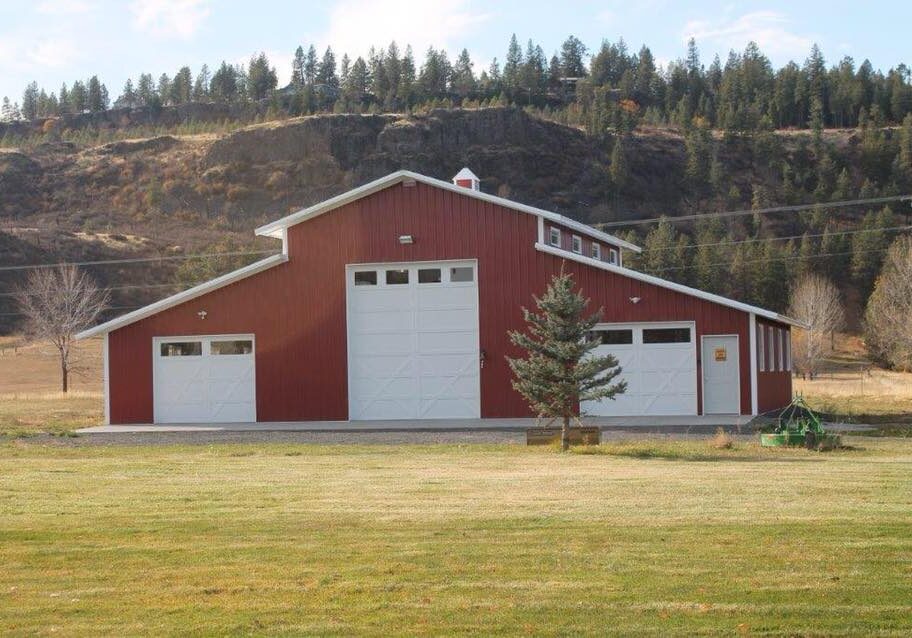
Spokane Zoning Regulations for Barndominiums
Building a barndominium in Spokane can be an exciting way to combine flexible living and workspace under one roof. But before you break ground, it’s essential to understand the zoning regulations that govern where and how you can build. At Stimson Contracting, we’ve guided many clients through Spokane County’s permitting and zoning process, and I’m here to share what you need to know to keep your project compliant and on track.
Table of Contents
1. Understanding Spokane County Zoning Districts
Spokane County divides land into several zoning districts—residential (R), rural residential (RR), agricultural (AG), and commercial/industrial. Most barndominiums fall into:
RR (“Rural Residential”): Minimum lot size of 1–5 acres, allows one single-family residence per parcel.
AG (“Agricultural”): Larger parcels (10+ acres), farm buildings and a dwelling are permitted.
Check your parcel’s zoning on the Spokane County Assessor’s online GIS map to confirm which rules apply.
2. Permitted Uses vs. Conditional Uses
In most residential and rural zones, a barndominium is treated as a single-family dwelling—a permitted use. If you plan to operate a business (e.g., workshop, short-term rental), you may need a Conditional Use Permit (CUP) to allow the commercial or home-based business component.
3. Lot Size and Density Requirements
Key lot standards include:
Minimum Lot Size: 1 acre in RR zones; 10 acres in AG zones.
Density: Typically one dwelling unit per parcel; cluster developments may allow more.
If you own a smaller lot, you’ll need to verify whether it’s legal nonconforming or if a variance is required.
4. Setback and Height Regulations
Setbacks and height limits ensure adequate spacing and sightlines:
Front Yard Setback: 20–30 feet from the road right-of-way.
Side Yard Setback: 5–10 feet from property lines.
Rear Yard Setback: 15–20 feet from the back property line.
Maximum Height: Generally 35 feet for residential structures; agricultural buildings sometimes allowed up to 50 feet.
Always confirm the exact distances on your parcel’s zoning designation sheet.
5. Accessory Dwelling Units (ADUs) and Barndominiums
If you’re building a separate living unit attached to a barn or workshop, it may be classified as an Accessory Dwelling Unit:
ADUs must be under 1,200 square feet or 50% of the primary dwelling’s footprint, whichever is smaller.
ADUs require their own address, utility hookup, and must meet building and fire code for residential occupancy.
A barndominium that integrates living and shop space under one roof avoids some ADU requirements, but still must meet single-family standards.
6. Special Permits: Variances and Conditional Use Permits
When your project doesn’t fit standard zoning—say you need reduced setbacks or more height—you can apply for:
Variance: Relief from a specific zoning standard (setback, height, lot coverage).
Conditional Use Permit: Allows a use not normally permitted outright (e.g., running a commercial business).
Both require public notice, hearings, and approval by the Hearings Examiner.
7. Septic, Well, and Utility Considerations
Most rural parcels rely on on-site septic systems and wells. Before building:
Obtain a Health District approval for your septic design and well permit.
Verify that power, gas, and water lines can be extended to your building pad.
Plan utility easements and coordinate inspections.
Delays in health or utility permits often hold up building permits—start these early.
8. Environmental and Critical Area Protections
Spokane County protects streams, wetlands, and steep slopes. If your site touches a critical area:
You may need environmental permitting through the County’s Land Services.
Buffer zones (50–200 feet) often prohibit construction.
Mitigation plans can allow limited development with habitat restoration.
Consult a site assessment early if you suspect environmental constraints.
9. Navigating the Application Process
Here’s a high-level overview:
Pre-Application Meeting: Meet with County planners to review your concept.
Site Plan Submission: Provide detailed drawings showing setbacks, building footprints, septic, and utilities.
Permit Review: Zoning, health, and building code review—often in parallel.
Public Notice & Hearing (if CUP or variance required).
Permit Approval & Issuance: Once all departments sign off, you receive your building permit.
Our team handles coordination with all County departments to keep things moving.
10. Conclusion: Building with Confidence
Understanding Spokane’s zoning regs before you design your barndominium saves time, money, and stress. From lot size and setbacks to ADU rules and environmental buffers, each requirement shapes your project. By working with experienced builders and planners—like the team at Stimson Contracting—you’ll navigate permitting smoothly and build a barndo that’s fully compliant and perfectly suited to your land.
📞 Call today to schedule a free site consultation 509.244.2636
🌐 Visit our website for Spokane-specific building tips
📧 Request a custom quote and timeline
Read our other articles:
- Home Page
Barndominiums in Spokane: Trendy, Durable, and Affordable
10 Reasons Pole Buildings Are the Future of Rural Construction
How to Choose the Right Pole Barn Contractor
Top Pole Barn Design Ideas for 2025
How to Plan Your Dream Shop Construction Project
What You Need to Know Before Building a Pole Barn in Spokane
The Pros and Cons of Living in a Barndominium
Spokane Shop Construction: Local Regulations to Know
Custom Pole Buildings: Options That Add Value
From Barn to Barndo: The Transformation Process
Spokane’s Growing Demand for Custom Commercial Buildings
Common Mistakes to Avoid with Pole Building Projects
Is a Pole Building Right for Your Small Business?
Why Pole Barns Are Ideal for Rural Spokane Properties
Can a Pole Barn Increase Your Property Value in Spokane?
Multi-Use Shop Buildings: Storage, Work, and More
7 Creative Uses for Pole Barns in Spokane
Exploring the Cost Per Square Foot of Pole Barns
10 Barndominium Myths Debunked
Building a Shop on a Budget Without Cutting Corners
Navigating Commercial Building Codes in Spokane
Turning a Pole Barn into a Livable Space
The Complete Guide to Pole Building Construction in Spokane
What Is a Barndominium and Why Should You Build One?
Shop Construction Mistakes to Avoid
Cost Breakdown: Building a Barndominium in 2025
Post-Frame vs. Pole Barn: What’s the Difference?
Spokane Area Shop Construction: Timeline Expectations
What Makes a Barndominium So Cost-Effective?
Top 5 Mistakes to Avoid When Building a Pole Barn
Tips for Constructing a Durable Warehouse
How to Insulate Your Pole Barn for All-Season Use
Is a Barndominium Right for Your Family?
How Long Do Pole Buildings Last? Lifespan and Maintenance
How to Make Your Shop Energy Efficient
Upgrading Your Existing Pole Building
Barndominium Floor Plans That Maximize Space and Style
Adding Insulation to Pole Buildings: Pros and Cons
Durable Flooring Options for Shop Spaces
How to Prepare Your Spokane Property for Pole Barn Construction
The Evolution of Pole Barn Design: Modern Features to Consider
How to Design a Multi-Use Pole Barn That Works for You
Luxury Barndominiums: Yes, It’s a Thing
How to Prepare a Commercial Lot for Building
Must-Have Add-Ons for Your Pole Barn Project
Barndo vs Tiny Home: Which One Fits Your Lifestyle?
Modern Office Construction: Open Space vs. Private
How to Select the Right Commercial Builder
Building a Custom Barndominium: What to Expect
Energy-Efficient Pole Buildings: Is It Possible?
Storage Solutions Inside Your Workshop
Tips for Adding Electrical and Plumbing to Your Shop
How to Incorporate Rustic Charm into Your Barndo
Mixed-Use Commercial Buildings: What to Know
How Weather Affects Pole Barn Construction in the Northwest
How to Add a Workshop to Your Barndominium
Spokane Zoning Regulations for Barndominiums
Spokane Businesses Love These Commercial Floor Plans
Shop Buildings for Hobbyists: What to Include
Spokane Horse Barn Builders
Spokane Indoor Arena Builders
Spokane Agricultural Farm Buildings
Spokane Airplane Hangar Builders
Spokane Commercial Building Builder
Pole Building Contractors in Airway Heights, WA
Pole Building Contractors in Medical Lake, WA
